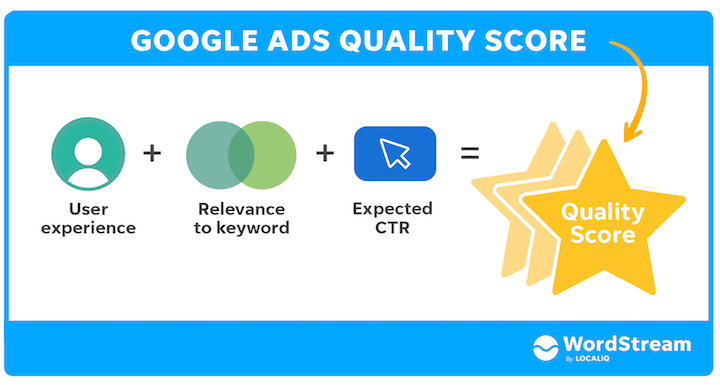Google Ads Quality Score: Everything You Should Know
Learn what the Google Ads Quality Score is, how it's calculated, and why it's important to improve it to scale your ad performance & increase your ROI.
Published November 5, 2024

In 1976, a 14-year-old girl from a virtually unknown country achieved the impossible. Nadia Comaneci received the first perfect score (a 10) in the history of gymnastics. And not just once, but six more times.
Not that’s quite a record. But unlike gymnastics, in the advertising world, Google Ads agencies and Google ads ecommerce agencies strive to get a perfect score on every one of their ad campaigns.
When you’re running Google Ads, your campaigns are also assessed by an algorithm and awarded a Quality Score. And just like in the case of gymnastics, a lot of factors go into achieving the highest Quality Score possible: hard work, historical performance, and keyword relevance (to name just a few).
Knowing your Quality Score helps you know where you stand - and what else you need to do to make sure your Google Ads campaigns are cost-efficient. So in this article, we're taking a closer look at what Quality Score is, which factors influence it, and how to make sure your campaigns get the highest score possible.
What is Quality Score?
The Google Quality Score is a system used by Google to measure the quality and relevance of your ads and landing pages, at a keyword level (on a scale from 1 to 10).
The Quality Score is determined by several factors, including the click-through rate (CTR), ad relevance, landing page experience, and historical performance. The higher your Quality Score, the lower the cost per click (CPC) for your ads.
Also, having a high Quality Score will also help your ads appear higher up in the ad rankings, so it’s an important measure to keep in mind as you optimize your campaign performance.
Pro tip: want to improve your Google Quality Score? Hire one of our top Google Ads experts today!
How is the Quality Score calculated?
The Quality Score is calculated on a keyword level, in real time, every time your keyword matches search queries (i.e. every time your keyword has the potential to match with a search term and trigger an ad).
The Quality Score algorithm is based on historical impressions for the searches made for your keyword, and the final score is influenced by a variety of factors.
So, in other words, Google will consider the number of impressions your chosen keyword had historically, to check how it has performed in the past and assess the likelihood of it performing well in the present.
Some of the primary factors that determine the Google Quality Score include - the expected click-through rate, keyword relevance, landing page quality, ad copy relevance, and your historical performance.
Let’s look at each one in more detail.
Expected Click-through-Rate (CTR)
The click-through rate (CTR) is the number of times people have clicked on your ads out of all the times it was shown. The higher your CTR, the higher your Quality Score, because it signals Google that your ad is good and relevant.
Keyword relevance
You need to have relevant keywords to your user’s search, on both the ad and the landing page. Your keywords must match the user intent and show Google that your content is relevant and answers their question or need, both in the ad itself and the Google Ads headline.
Landing page quality
The Quality score will also take your landing page into account. Google looks for how relevant, useful, and easy to navigate your landing page is. Additionally, it considers the landing page load time, as well as the landing page design and content (both text and images).
In essence, you should always aim for a good landing page user experience - which, in turn, will tell Google that your ads are relevant and worthy of a higher Quality Score. Don't say your ad is about chocolate when your landing page is about sugar-free drinks -- stay relevant and always ensure the landing page matches your actual ads.
Remember that your landing page Quality Score is important for both Search Ads as well Google Discovery Ads.
Ad copy relevance
Of course, your ad copy also influences Quality Score. Your ad text needs to be relevant and specific to the keywords you're bidding on. Generic ads are usually seen as irrelevant, which means that your Quality Score will decrease. And you need a real SEM expert to help you nail your ad copy.
Historical account performance
If your Google Ads account has a history of well-performing ads, it has a better chance of getting a higher Quality Score. That's because Google looks at how well you've performed in the past and uses this as an indication of your ad quality and relevance.
Additionally, there are also factors that signal ad quality, but which might not be included in the Google Quality Score calculation. Some examples include the type of device used in the search, the user and the device location, and the time of the day.
You should also consider device performance and its impact on your ad campaign. For instance, if users click on your ads from older types of devices and have a suboptimal user experience, it could decrease your CTR, and your overall conversion rate, and could negatively affect your Google AdWords Quality Score.
How to check your Quality Score
Here’s how to check your Quality Score from your Google Ads account:
- Log in to your Google Ads account
- Go to the “Keywords” tab
- Select the keyword you want to check
- Look at the column labeled “Quality Score”. The Quality Score will be displayed as a number from 1-10, with 10 being the best, and 1 being the lowest score.
Keep in mind that you can also view past Quality Scores by looking at the "Quality Score (hist)." metrics. Doing this will help you see how your Quality Score changed over time, as well as which factors are influencing it.
It is worth noting that the Quality Score of your ads is only shown for Search Ads (not Display Network Ads). So if you run Display Network campaigns, your ads will be ranked and scored just as in the case of Search campaigns, but your score will not be displayed in your Google Ads account.
Benefits of improving your Google Quality Score
Improving your Google Quality score is not only possible, it's also recommended. Here are two of the most important reasons to boost your Google Quality score:
It improves your Ad Rank
Your Google Ad Rank is the position of your ad in the search engine results page. It is determined by taking a series of factors into consideration:
- Bidding amount
- Auction time
- Ad quality (which includes the same factors as the Quality Score)
This means that if you have a higher Quality Score, your Ad Rank will also be higher. It lowers your cost per click (CPC)
When you have a higher Google Ads score, your cost per click will also be lower (and thus, your cost per conversion will also be lower). Consequently, a high Quality Score will save you money, get more out of your budget, and increase your ROAS (Return on Ad Spend).
What’s a good quality score?
Generally, you want your Quality Score to be as high as possible, but what a "good" Quality Score is depends on the type of keyword you're targeting, as well as your bidding strategy.
According to Wordstream, if you're going for branded keywords, you should aim for a Quality Score of 8 (or higher). If you're going for commercial keywords with high search intent, you should aim for a Quality Score of 7 to 9.
If your keyword is low-intent, a Quality Score of 7 (or higher) is what you're looking for. And if you're bidding on competitor names or keywords, a Quality Score of 3 is already considered good.
5 ways to increase your Quality Score
Want to improve your Google Ads Quality Score? Here are five ways to do it:
1. Improve the relevance of your ad
They best way to improve your quality score is to improve the relevance of your ad. For instance, if you're targeting the "dotted socks" keyword, your ads should mention "dotted socks" - not just "socks". Likewise, if you create ads for Google Display Network campaigns, your ad visuals and copy should reflect the product you're selling (e.g. "dotted socks.")
2. Improve the expected click-through rate (CTR)
As mentioned before, the expected clickthrough rate is one of the factors that signals ad quality and helps Google calculate your Quality Score. This means that, if you want to improve your Quality Score, you should also focus on improving your CTR:
- Write compelling ad copy
- Create an eye-catching and relevant image for your ads
- Experiment with different ad formats
- A/B test different copy and design variations to see which one works best
3. Improve the landing page experience
Your landing page Quality Score is tightly connected to your ad relevance. This means you should include the same terms, visuals, and information from your ad on your landing page. Keep in mind that, for a flawless landing page user experience, everything should be spot-on, including:
- Your landing page content
- Landing page design and usability
- Landing page relevance (to target keywords and audience)
- Landing page load times (on desktop and mobile devices)
- Powerful CTAs sprinkled throughout the entire landing page
4. Group your keywords better
The more accurate your keyword groups are, the higher your Google Ads score will be. This means that you should group your keywords by theme or message, and create a unique ad for each keyword group. You should also maintain the same keyword groupings in different ad groups and campaigns so you can keep your targeting relevant and efficient.
Both individual keywords and keyword groups influence how effective your Google Ads campaigns will be. Furthermore, keep in mind the following tips as well:
- Watch out for keyword quality
- Avoid keyword stuffing on landing pages (for a good user experience)
- Aim for long-tail keywords
Using the Google Keyword Planner will help you find the best keywords for your campaigns – and thus improve your Quality Score too.
5. Add negative keywords
Negative keywords enable you to refine your search query and help you reach the people who are actually interested in what you're offering. So if you add negative keywords to your ad campaigns, you can make sure that your ads will only be shown to the people who are actively searching for what you're offering.
For example, if you sell colorful socks, you can add “red” as a negative keyword to make sure that your ads won't show up when someone searches for specific red socks. Or if the socks you sell are quirky, you might also want to use "fashion socks" as a negative keyword, to make sure you avoid displaying your ad to people who might be looking for more stylish socks.
Recap
Google Ads changed the history of advertising by offering businesses a traceable, measurable way to advertise their products and services. We’ve come a long way from not knowing how traditional ads perform (or why) to having clear data on how efficient our efforts are.
Improving your Quality Score is about more than just numbers, though. It’s about building a seamless user experience from the moment the internet user sees your ad to the moment they click on the “buy” button.
Achieving a good Quality Score can ensure better ROI for your business. And if you’re not sure where to start, hiring a Google Ads expert can help you make the most out of your time and money, turn your advertising budget into actual advertising revenue, and bring more customers to your doorstep.







